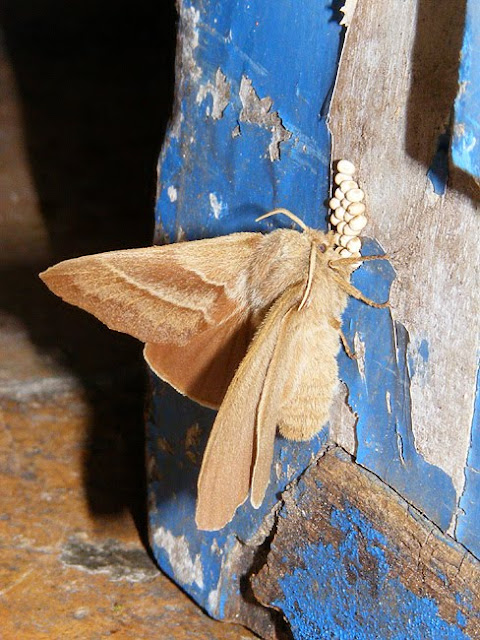There are a couple of orange and black striped caterpillars that you will commonly encounter in the Loire Valley in the summer. The French for caterpillar is chenille.
Cinnabar Moth caterpillars
Tyria jacobaeae
Goutte-de-sang (= 'drop of blood')
The species is found all over France, but is particularly abundant in the north-western quarter of France. Nearly always when you see the caterpillar it will be on ragworts Jacobaea spp (Fr. Seneçons), and you rarely see just one, but usually small groups of them, often near the top of the plant. They have the disconcerting habit of twitching and waving their heads when disturbed. This is presumably a defence mechanism, to remind you that they are toxic, due to the plant toxins they've consumed in eating the host plant. They can be found anywhere there is ragwort -- dry grasslands, scrub, domestic and public urban gardens, roadsides and railway tracks. There are some concerns that the species is declining because its host plant ragwort is commonly destroyed as a toxic weed.
 | |
| Cinnabar moth Tyria jacobaeae caterpillars on Common Ragwort Jacobaea vulgaris. Photographed July 2020 in my orchard, Indre et Loire. |
Fox moth
Macrothylacia rubi
Bombyx de la Ronce (= 'bramble silkworm moth')
Another very abundant species in the Loire Valley. The caterpillars change appearance several times as they grow, but in their middle stage they are black and velvety, with fine orange stripes. They are often encountered alone, and crossing a bitumen road. They are particularly abundant in the Paris Basin and central lowland France, but can be found throughout France. They are not very fussy about habitat, being found on land dominated by herbaceous (non-grass) species, lichens or mosses; woodland edges and clearings dominated by tall herbaceous (non-grass) species; alpine and sub-alpine grasslands; hot grasslands; wet or seasonally wet grasslands; heaths; open woodland; hedgerows; and open unwooded grasslands. The caterpillars eat all sorts of low growing plants such as brambles, heather and other low shrubs.
 |
| Fox moth Macrothylacia rubi caterpillar. Photographed July 2020 in my driveway. |
 |
| Fox moth Macrothylacia rubi caterpillar. Photographed in a garden in a rural hamlet. |
 |
| Female Fox moth Macrothylacia rubi laying her eggs on the front door of a cottage in a rural hamlet. Photo taken May 2010 in Roux. |







No comments:
Post a Comment